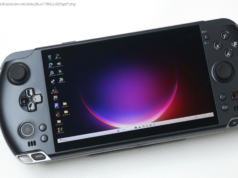The Moto Z3 is the “first 5G phone,” in that it will have an optional add-on for Verizon’s 5G network next year.
The Moto Z3 is the first 5G phone —with an asterisk. Motorola has been promising a 5G add-on Moto Mod for its modular Z line of phones for a while now, and the Z3 is the first one that will officially get it. It’ll be for Verizon’s 5G network, and it will come “early in 2019,” according to Verizon network chief Nicola Palmer. That means until then the Z3 has to stand on its own merits. The specs are fairly midrange, consisting of last year’s processor and a 1080p screen. Fortunately, the Z3 is priced accordingly at $479.99, making it more affordable than the unlocked Z3 Play. It doesn’t match top-tier phones like the Samsung Galaxy Note 9 in sheer power, but its combination of price, performance, and the unique Moto Mods functionality allow it to hold its own among midrange competitors.
The Z3 is easy to confuse with the rest of Motorola’s Z-series. It looks a lot like the Moto Z2 Force Edition and is almost identical to the Z3 Play. The Z3 on Verizon is a slim, metal slab with a shimmery glass back. It measures 6.2 by 3.0 by 0.27 inches (HWD) and weighs 5.5 ounces. It’s a little thicker and heavier than last year’s phone (6.1 by 3.0 by 0.24 inches, 5.04 ounces), but it has a slightly larger battery. It’s a little bit too wide to be comfortable to use one-handed, but the bezels are thin due to the 18:9 aspect ratio. Keep in mind that Moto Mods will add considerably to the thickness and bulk, unless all you’re using is a basic Style Back.
Above: Moto Z3, Moto Z3 Play
Like the Z3 Play, the fingerprint sensor has been moved to the right side, under the volume buttons. The left side of the phone has a ridged power button, while the bottom has a USB-C charging port. The top has a SIM/microSD card slot that worked fine with a 256GB card during out testing.
There’s no 3.5mm headphone jack, but the phone does ship with a USB-C dongle for wired audio. The magnetic connector pins on the bottom work with Moto Mods, letting you easily snap on various backs for added functionality. The phone is splash resistant, but not waterproof.
The Z3 has the same screen as the Z3 Play. On the front, you’ll find an 18:9,6-inch, 2,160-by-1,080 AMOLED screen with saturated colors and inky blacks. The resolution works out to a crisp 402 pixels per inch. It won’t be as sharp as the Quad HD Samsung Galaxy S9 (570ppi), but it’s on par with the 1080p OnePlus 6 (402ppi). Viewing angles are great, and the screen gets quite bright, making it easy to use under direct sunlight. You can adjust screen color temperature and saturation to suit your preferences in the Settings menu.
Above: Moto Z3, Moto Z3 Play
You can use Moto Actions on the Z3 (enabled through the Motorola app). This includes various gestures like twisting the phone to launch the camera app or chopping twice to trigger the flashlight. There’s a handy active display that displays time, date, and notifications when you pick the phone up.
If you want to save some screen real estate, you can switch between Android virtual buttons or a new, Android P/iOS-like horizontal bar, which uses taps and swipes to navigate. We started using it with the Z3 Play and found it quite easy to use once we got the hang of it.
Out of the box the Z3 runs on Verizon’s network and supports LTE bands (1/2/3/4/5/7/8/12/13/17/20/26/28/34/38/39/40/41/46/66). This allows it to have great connectivity in heavily congested midtown Manhattan, where we reliably had solid downlink and uplink, with a high of 17.2Mbps down and 10.1Mbps up.
Call quality is decent. Transmissions do sound robotic, but clarity is good and noise cancellation does a great job of blotting out most background noise with only minor distortion. The earpiece doubles as the primary speaker, allowing for good speakerphone calls, but average music playback.
Other connectivity protocols supported include dual-band Wi-Fi, NFC, and Bluetooth 5.0 for wireless listening on more than one audio device at a time.
Moto Mods is where things get interesting. The Z3 is backward-compatible with all the Moto Mods that have been released to date and works with everything from the various battery Mods to the Moto Gamepad. But what makes the Z3 compelling is that the bleeding-edge 5G Mod will connect to Verizon’s millimeter-wave 5G network using four Qualcomm antenna arrays on different sides of the device. That’s because millimeter-wave signals are very easy to block: If your hand covers an antenna, speeds plummet. Installing the quartet of antenna arrays is a way around that, as you’re unlikely to cover them all.
Inside, the Mod has a Qualcomm Snapdragon X50 5G modem, an X24 4G modem, and its own 2,000mAh battery that it shares with the phone. The phone, meanwhile, has its own slower X16 4G modem. Here’s how they all work together: When the mod is strapped on, the X16 goes into a low-power listening mode. All 4G data transfer goes through the X24, which can achieve 4G speeds up to 2Gbps, double the speed of the X16. If the phone needs to make or receive a voice call, or coverage drops to 3G or 2G, the X16 turns back on to handle the call or process the slower data.
Moto told us the reasons for all of these handoffs basically comes down to making sure the software is stable. It was easiest to implement the X24 in a 4G, data-only mode, as opposed to figuring out how to route call audio into it. (An app-based, as opposed to VoLTE or traditional, call over 4G would go through the X24, because of how and where VoLTE audio is encoded in the device versus over-the-top-audio.)
See How We Test Phones
Verizon’s network tells the X24 when 5G is available, and if it’s available, the X24 goes into a lower-power mode and the X50 takes over. Now, yes, this means that in 5G mode, you’ll have one active 5G modem and two listening 4G modems, so it’s all going to use up more battery power than the integrated Qualcomm 4G/5G solution we expect to see announced at the Qualcomm Snapdragon Summit this December. But Motorola insists that between the Mod’s 2,000mAh battery and the phone’s 3,000mAh you’ll still get a “full day” of use.
From a subscription perspective, the Mod acts like “a data card connected to your phone,” according to Moto engineers. That means it has its own embedded SIM and its own subscription—but Verizon isn’t saying anything yet about service plans or whether it can be swapped between phones. It will also work as a Wi-Fi hotspot (with your phone) and as a USB-C modem for a PC (with your phone). Last year, Verizon execs promised to greatly loosen data caps for 5G, but we haven’t heard an update since then.
The Mod will initially work only with the Z3, although Moto said it’s working on making it compatible with earlier generations of Verizon Moto Z phones. That’s a software challenge, not a hardware one, so it’s apparently possible. The Mod will only work on Verizon’s 5G network, not any other carrier’s, though. And it makes the phone thick and heavy.
The Z3 is powered by a Qualcomm Snapdragon 835 processor. The 835, which was last year’s flagship chip, doesn’t support 5G, but all of that magic will come in the aforementioned Mod. We asked Motorola about that 835 processor choice, and the answer was basically that it’s good enough. Upgrading to the Snapdragon 845 would enable a few extra features, such as higher-quality 4K recording, which could be compelling in a 5G environment, but the 835 is still a respectable processor, especially when paired with a 1080p rather than a 2K screen.
In the PCMark benchmark, which measures a variety of tasks like web browsing and photo and video editing, the Z3 scored 7,378.






